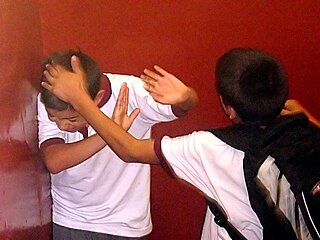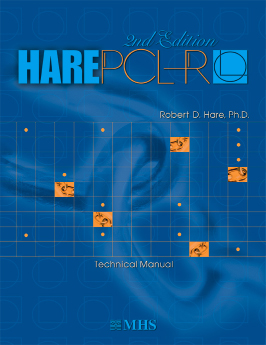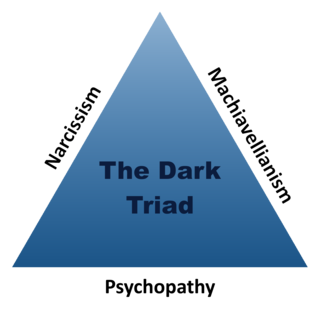
Conduct disorder (CD) is a mental disorder diagnosed in childhood or adolescence that presents itself through a repetitive and persistent pattern of behavior that includes theft, lies, physical violence that may lead to destruction, and reckless breaking of rules, in which the basic rights of others or major age-appropriate norms are violated. These behaviors are often referred to as "antisocial behaviors", and is often seen as the precursor to antisocial personality disorder; however, the latter, by definition, cannot be diagnosed until the individual is 18 years old. Conduct disorder may result from parental rejection and neglect and can be treated with family therapy, as well as behavioral modifications and pharmacotherapy. Conduct disorder is estimated to affect 51.1 million people globally as of 2013.
Antisocial personality disorder, sometimes referred to as dissocial personality disorder, is a personality disorder characterized by a limited capacity for empathy and a long-term pattern of disregard for or violation of the rights of others, starting before one was 15 years old. Other notable symptoms include impulsivity, reckless behavior, a lack of remorse after hurting others, deceitfulness, irresponsibility, and aggressive behavior.

Remorse is a distressing emotion experienced by an individual who regrets actions which they have done in the past that they deem to be shameful, hurtful, or wrong. Remorse is closely allied to guilt and self-directed resentment. When a person regrets an earlier action or failure to act, it may be because of remorse or in response to various other consequences, including being punished for the act or omission. People may express remorse through apologies, trying to repair the damage they've caused, or self-imposed punishments.
Child psychopathology refers to the scientific study of mental disorders in children and adolescents. Oppositional defiant disorder, attention-deficit hyperactivity disorder, and autism spectrum disorder are examples of psychopathology that are typically first diagnosed during childhood. Mental health providers who work with children and adolescents are informed by research in developmental psychology, clinical child psychology, and family systems. Lists of child and adult mental disorders can be found in the International Statistical Classification of Diseases and Related Health Problems, 10th Edition (ICD-10), published by the World Health Organization (WHO) and in the Diagnostic and Statistical Manual of Mental Disorders, Fifth Edition (DSM-5), published by the American Psychiatric Association (APA). In addition, the Diagnostic Classification of Mental Health and Developmental Disorders of Infancy and Early Childhood is used in assessing mental health and developmental disorders in children up to age five.

Sadistic personality disorder was a proposed personality disorder defined by a pervasive pattern of sadistic and cruel behavior. People with this disorder were thought to have desired to control others. It was believed they accomplish this through the use of physical or emotional violence. This diagnosis appeared in an appendix of the Diagnostic and Statistical Manual of Mental Disorders (DSM-III-R). The later versions of the DSM do not include it. It was removed as psychiatrists believed it would be used to legally excuse sadistic behavior.

Malignant narcissism is a psychological syndrome comprising a mix of narcissism, antisocial behavior, sadism, and a paranoid outlook on life. Malignant narcissism is not a diagnostic category defined in the Diagnostic and Statistical Manual of Mental Disorders (DSM-IV-TR). Rather, it is a subcategory of narcissistic personality disorder (NPD) which could also include traits of antisocial personality disorder or paranoid personality disorder.
Psychopathy, or psychopathic personality, is a personality construct characterized by impaired empathy and remorse, in combination with traits of boldness, disinhibition, and egocentrism. These traits are often masked by superficial charm and immunity to stress, which create an outward appearance of apparent normalcy.

The Psychopathy Checklist or Hare Psychopathy Checklist-Revised, now the Psychopathy Checklist—revised (PCL-R), is a psychological assessment tool that is commonly used to assess the presence and extent of psychopathy in individuals—most often those institutionalized in the criminal justice system—and to differentiate those high in this trait from those with antisocial personality disorder, a related diagnosable disorder. It is a 20-item inventory of perceived personality traits and recorded behaviors, intended to be completed on the basis of a semi-structured interview along with a review of "collateral information" such as official records. The psychopath tends to display a constellation or combination of high narcissistic, borderline, and antisocial personality disorder traits, which includes superficial charm, charisma/attractiveness, sexual seductiveness and promiscuity, affective instability, suicidality, lack of empathy, feelings of emptiness, self-harm, and splitting. In addition, sadistic and paranoid traits are usually also present.

The dark triad is a psychological theory of personality, first published by Delroy L. Paulhus and Kevin M. Williams in 2002, that describes three notably offensive, but non-pathological personality types: Machiavellianism, sub-clinical narcissism, and sub-clinical psychopathy. Each of these personality types is called dark because each is considered to contain malevolent qualities.
Personality disorders (PD) are a class of mental disorders characterized by enduring maladaptive patterns of behavior, cognition, and inner experience, exhibited across many contexts and deviating from those accepted by the individual's culture. These patterns develop early, are inflexible, and are associated with significant distress or disability. The definitions vary by source and remain a matter of controversy. Official criteria for diagnosing personality disorders are listed in the sixth chapter of the International Classification of Diseases (ICD) and in the American Psychiatric Association's Diagnostic and Statistical Manual of Mental Disorders (DSM).
In psychology, grandiosity is a sense of superiority, uniqueness, or invulnerability that is unrealistic and not based on personal capability. It may be expressed by exaggerated beliefs regarding one's abilities, the belief that few other people have anything in common with oneself, and that one can only be understood by a few, very special people. The personality trait of grandiosity is principally associated with narcissistic personality disorder (NPD), but also is a feature in the occurrence and expression of antisocial personality disorder, and the manic and hypomanic episodes of bipolar disorder.
In psychology, manipulation is defined as an action designed to influence or control another person, usually in an underhanded or unfair manner which facilitates one's personal aims. Methods someone may use to manipulate another person may include seduction, suggestion, coercion, and blackmail to induce submission. Manipulation is generally considered a dishonest form of social influence as it is used at the expense of others.
The Levenson Self-Report Psychopathy scale (LSRP) is a 26-item, 4-point Likert scale, self-report inventory to measure primary and secondary psychopathy in non-institutionalized populations. It was developed in 1995 by Michael R. Levenson, Kent A. Kiehl and Cory M. Fitzpatrick. The scale was created for the purpose of conducting a psychological study examining antisocial disposition among a sample of 487 undergraduate students attending psychology classes at the University of California, Davis.
Psychopathy, from psych and pathy, was coined by German psychiatrists in the 19th century and originally just meant what would today be called mental disorder, the study of which is still known as psychopathology. By the turn of the century 'psychopathic inferiority' referred to the type of mental disorder that might now be termed personality disorder, along with a wide variety of other conditions now otherwise classified. Through the early 20th century this and other terms such as 'constitutional (inborn) psychopaths' or 'psychopathic personalities', were used very broadly to cover anyone who violated legal or moral expectations or was considered inherently socially undesirable in some way.
George Everett Partridge was an American psychologist credited with popularizing the term sociopath in 1930 that Karl Brinbaum had suggested in 1909. He worked with the influential G. Stanley Hall at Clark University. One year after his death, the George Everett Partridge Memorial Foundation was incorporated in 1954 by the Partridge family to memorialize his life's work in the study and treatment of mental and personality disorders. The Foundation focused on developing programs to promote treatment centers for mentally disabled children, often referred to as the "forgotten children." Partridge schools were established. The first of which was in Herndon, Virginia, for older boys with moderate mental retardation resulting from brain damage. However, the foundation was forfeited in 1991.

Essi Maria Viding is Professor of Developmental Psychopathology at University College London in the Faculty of Brain Sciences, where she co-directs the Developmental Risk and Resilience Unit, and an associate of King's College London's Institute of Psychiatry, Psychology and Neuroscience. Viding's research focuses on development of disruptive behaviour disorders, as well as children and young people's mental health problems more broadly. She uses cognitive experimental measures, brain imaging and genetically informative study designs in her work.
Evolutionary psychiatry, also known as Darwinian psychiatry, is a theoretical approach to psychiatry that aims to explain psychiatric disorders in evolutionary terms. As a branch of the field of evolutionary medicine, it is distinct from the medical practice of psychiatry in its emphasis on providing scientific explanations rather than treatments for mental disorder. This often concerns questions of ultimate causation. For example, psychiatric genetics may discover genes associated with mental disorders, but evolutionary psychiatry asks why those genes persist in the population. Other core questions in evolutionary psychiatry are why heritable mental disorders are so common how to distinguish mental function and dysfunction, and whether certain forms of suffering conveyed an adaptive advantage. Disorders commonly considered are depression, anxiety, schizophrenia, autism, eating disorders, and others. Key explanatory concepts are of evolutionary mismatch and the fact that evolution is guided by reproductive success rather than health or wellbeing. Rather than providing an alternative account of the cause of mental disorder, evolutionary psychiatry seeks to integrate findings from traditional schools of psychology and psychiatry such as social psychology, behaviourism, biological psychiatry and psychoanalysis into a holistic account related to evolutionary biology. In this sense, it aims to meet the criteria of a Kuhnian paradigm shift.
Externalizing disorders are mental disorders characterized by externalizing behaviors, maladaptive behaviors directed toward an individual's environment, which cause impairment or interference in life functioning. In contrast to individuals with internalizing disorders who internalize their maladaptive emotions and cognitions, such feelings and thoughts are externalized in behavior in individuals with externalizing disorders. Externalizing disorders are often specifically referred to as disruptive behavior disorders or conduct problems which occur in childhood. Externalizing disorders, however, are also manifested in adulthood. For example, alcohol- and substance-related disorders and antisocial personality disorder are adult externalizing disorders. Externalizing psychopathology is associated with antisocial behavior, which is different from and often confused for asociality.

In the field of personality psychology, Machiavellianism is the name of a personality trait construct characterized by interpersonal manipulation, indifference to morality, lack of empathy, and a calculated focus on self-interest. Psychologists Richard Christie and Florence L. Geis named the construct after Niccolò Machiavelli, as they used truncated and edited statements similar to his writing style to study variations in human behaviors. Their Mach IV test, a 20-question, Likert-scale personality survey, became the standard self-assessment tool and scale of the Machiavellianism construct. Those who score high on the scale are more likely to have a high level of manipulativeness, deceitfulness and a cynical, unemotional temperament.
The influence of childhood trauma on the development of psychopathy in adulthood remains an active research question. According to Hervey M. Cleckley, a psychopathic person is someone who is able to imitate a normal functioning person, while masking or concealing their lack of internal personality structure. This results in an internal disorder with recurrent deliberate and detrimental conduct. Despite presenting themselves as serious, bright, and charming, psychopathic people are unable to experience true emotions. Robert Hare's two factor model and Christopher Patrick's triarchic model have both been developed to better understand psychopathy; however, whether the root cause is primarily environmental or primarily genetic is still in question.







